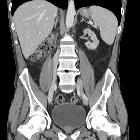Miller-Dieker syndrome (MDS)

Miller-Dieker syndrome (MDS) or is a rare chromosomal anomaly and is one of the conditions considered part of lissencephaly type I (classic) . It is the form of lissencephaly that is most recognizable on prenatal imaging due to its severity .
Clinical presentation
Features include:
- CNS
- neuronal migrational anomalies: lissencephaly type I
- prominent subarachnoid spaces
- widened cerebral ventricles
- craniofacial
- microcephaly
- calvarial thickening
- bi-temporal pitting
- prominent occiput
- micrognathia
- microgenia
- auricular dysplasia
- flared nostrils
- other
- corneal clouding
Pathology
Genetics
It results from a deletion in chromosome 17p13.3, which includes the PAFAH1B1 and YWHAE genes. It is thought to carry an autosomal dominant inheritance.
Associations
Radiographic features
Antenatal ultrasound
May show many of the above clinicopathological features. There may also be evidence of intra-uterine growth restriction (IUGR).
MRI
The features are those of type I lissencephaly. The brain is usually grossly abnormal in outline, with only a few shallow sulci and shallow Sylvian fissures, taking on an hour glass or figure-8 appearance on axial imaging. The cortex is markedly thickened measuring 12-20 mm (rather than the normal 3-4 mm) .
Treatment and prognosis
The overall prognosis is poor with most fetuses not surviving beyond infancy. There may be recurrence rate of ~25% for future pregnancies.
History and etymology
The syndrome is named after J Q Miller and H Dieker.
See also
- classification system for malformations of cortical development
- lissencephaly
- lissencephaly type I-subcortical band heterotopia spectrum
Siehe auch:
- Kryptorchismus
- Herzfehler
- angeborene renale Anomalien
- Lissenzephalie
- Mikrognathie
- Mikrozephalie
- Intrauterine Wachstumsretardierung
- chromosomale Anomalien
- microgenia
- Lissenzephalie Typ 1
- kortikale Malformation
und weiter:

 Assoziationen und Differentialdiagnosen zu Miller-Dieker Syndrom:
Assoziationen und Differentialdiagnosen zu Miller-Dieker Syndrom:







